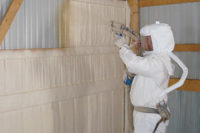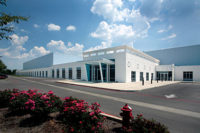Get it Right

In the North American construction market, spray polyurethane foam is gaining wide recognition for a number of reasons. First, it provides strong insulating properties. Second, spray foam allows builders to create a tight building envelope around the entire building. This not only saves in energy costs by helping to prevent air leakage, but also facilitates improved air quality within the building. Achieving a tight building envelope is the foundation for an energy-efficient building.
A significant portion of a building’s energy costs are lost due to heating or cooling outside air that infiltrates through gaps, cracks and transitions. According to the Department of Energy, a tight building, well insulated with spray foam, can help save a building owner 30 to 50 percent on his energy bills.
However, before spray foam can be applied to a building, stringent safety requirements and industry best practices must be followed. These include selecting a reputable spray foam applicator, ensuring proper work site safety and working with sub-trades to create a safe work environment.

Choosing an Applicator
By following a few guidelines, builders and general contractors can be assured that the spray foam material being applied into a wall and ceiling assembly, attic, floor or crawl space, will meet all of the needed building code requirements and be installed safely.Right now, the construction market is seeing a rise in start-up spray foam companies who are stepping up to meet the increase in market demand. So, how does a builder know whether or not the applicator will make the grade? The builder needs to start with the basic questions:
Is the spray foam applicator experienced in installing spray foam in a specific market? Is spray foam the main part of the company’s business? Is the company’s main business fibrous insulation, air conditioning and heating equipment installation, painting or remodeling, etc.?
- Does the spray foam applicator specialize in a particular type of spray foam job, i.e., residential, commercial, roofs, etc.?
- Does the spray foam applicator have the proper insurance?
- Does the spray foam applicator have qualified references and can the applicator cite multiple spray foam experiences with buildings?
- At the job site, are the employees using the correct personal protective equipment?
Applicator Training Programs
Many spray foam material distributors and manufacturers host spray foam schools designed to share industry best practices with applicators. Schools often include both classroom education and hands-on application and troubleshooting training. Topics covered typically include:- Health and safety
- Material handling
- Equipment maintenance and operation
- Job site preparation and spray application
- Troubleshooting
- Product storage
- Building science
- Application techniques
Additional courses and spray foam accreditations are also available via the Spray Polyurethane Foam Alliance (www.sprayfoam.org) and the Center for the Polyurethanes Industry (www.polyurethane.org). These trade associations provide educational and technical resources for the spray foam industry.
Business Considerations
When it comes to a spray foam job, the price of the bid cannot be the only consideration. Even after an applicator has been selected, it is crucial to maintain oversight of the project. It is also recommended that from time-to-time, the project manager stops by the job site unannounced. This will help verify that the applicator is upholding industry-mandated standards and OSHA safety practices. These safety practices include applying the spray foam to the recommended thicknesses and making sure the applicators are wearing the appropriate PPE during all phases of the application-the preparation, spraying and scarfing. Once a safe job site has been established, workmanship becomes the top priority.
Before the Job
Job Scope and Product SpecificationPrior to starting the project, the entire job needs to be scoped and products need to be selected. The products selected should meet the requirements of the International Building Code and International Residential Code, particularly in the area of fire performance. Acceptance criteria AC-337 has been developed by the industry to allow for the creation of evaluation service reports and the simplification of code compliance. When used in non-combustible construction, spray foam products and the wall assemblies specified should be checked for compliance with the requirements found within the IBC.
In addition, the scope should include the use of the ignition and thermal barriers, as required by the code. Foam adjacent to occupied space that will not be covered by gypsum board, including plenum spaces, needs to be covered with a 15-minute thermal barrier. Some thermal barriers, such as certain types of spray-applied cementitious coatings, spray-applied cellulosic materials and spray-applied rockwool, have met the criteria of NFPA 275. These products can be applied over all foamed plastics.
Other thermal barriers that may be used will have passed a large scale fire test (e.g., modified NFPA 286 or UL 1715). Additionally, they will be outlined in the foam’s evaluation services report or in a valid test report. In attics and crawl spaces, a less stringent ignition barrier criterion is applicable. Again, a large scale test determines which intumescent coating can be used in conjunction with the specified foam. Many closed cell foams and some open cell foams also meet this standard in the large scale test without a coating at all.
Lastly, it’s important to ensure that the building as a system is going to work properly together. In particular, it should be ensured that the assembly designs are appropriate for the climate and application. For spray foam applications on the outside of the wall assembly, flashing may be required at transitions, seams and joints. Also, heating, ventilation and air conditioning (HVAC) systems need to be right-sized for the tight building. This will help ensure excellent indoor air quality, including ventilation, combustion safety and moisture control considerations.
Mock up
For commercial applications, a mock up is advised to check compatibility with other materials, define the order of work and ensure that all the trades that will be working on the wall will work well together.
Site Preparation
Prior to spraying, all surfaces must be clean and dry. A few surfaces, such as some metals, may require a primer. Windows, doors and HVAC openings should be masked off to prevent overspray. Consideration should also be given to proper handling of items, such as recessed lights, furnaces or other potentially hot surfaces. For exterior applications, precautions should be taken to avoid overspray on adjacent buildings, cars, etc.

Day of the Job
Required PPEOn the day of the job, the SPF contractor should be wearing the proper PPE. For interior applications of high-pressure spray foam, the OSHA requires the following PPE:
Gloves: To avoid direct skin contact, fabric gloves fully coated with nitrile, neoprene, butyl rubber or PVC must be worn while applying spray foam. Tape may be used to seal arm and feet openings as needed.
Work Boots: To avoid foot injury, steel-toed work boots covered by disposable over-boots, should be worn in most work areas. In cases where over-boots may present a slip/fall hazard, they may be eliminated.
Respirator/ Eye Protection: To avoid inhalation and eye injury caused by foam aerosol or mist, a NIOSH-approved, full-face or hood-type supplied air respirator (SAR) operated in positive pressure or continuous flow mode must be used.
Protective Clothing: To avoid direct skin contact, disposable coveralls with an attached hood and disposable over-boots with skid-resistant soles must be worn. In cases where heat stress may be of concern, a light-weight, disposable coverall should be considered.
Hard Hat (outdoors, when needed): To avoid head injury, an approved hard hat must be worn in areas where there is a risk of falling objects.
Coordination of Trades/Re-entry Time
During the application of spray foam, other trades should not be present in the vicinity of the spray area. For residential construction and small commercial jobs, this would mean no other trades on the site during the spray without the proper PPE. During application, the spray area should be roped off and clearly marked with no entry signs. Safe re-entry time is typically 24 hours from the end of the spraying.

Retrofits have a number of special considerations. First, no one should be at home during the spraying. Occupants should not return until after completion of the job. Twenty-four hours is typical, however this will vary by manufacturer. The HVAC system should be shut off to minimize the distribution in the immediate vicinity of the spray area to the rest of the building. If feasible, the spray area should be ventilated with fans drawing air from the space and ejecting it from the building.
Quality Control
To meet industry standards, spray foam should be applied at the specified thickness and density with any necessary flashings. The applicator should always wear the proper PPE and adhere to proper processing parameters. These include maintaining the spray foam’s proper chemical temperature and pressure during installation.
On the day of the job, the SPF contractor should be conducting basic quality control measures. These include:
- Logging foam lot numbers
- Logging ambient temperature and humidity
- Ensuring proper temperature set points and equipment performance
- Visually inspecting foam for off-ratio foam
- Checking thickness and density
- Ensuring adhesion
Ideally, the results of these inspections should be logged into a daily work log to reinforce quality and provide data if a problem were to arise at a later date.

After the Job
Quality Assurance ProgramsBuilders and contractors may also choose have a third party verify that the product being applied is in accordance with a quality assurance program. The QAP verifies that the spray foam has been installed correctly and that it meets industry and manufacturer guidelines. In most QAP engagements, the manufacturer agrees to only sell products to accredited and licensed applicators that employ trained, certified and licensed installers. The manufacturer also has input into the requirements and agrees beforehand that the requirements are acceptable.
In many cases, the manufacturer then relies on the applicator to provide proof that it is meeting installation requirements. However, a third party may be used for inspection and compliance with QAP programs. These third parties may be hired by the manufacturer. An independent organization, such as the Air Barrier Association of America, also provides quality assurance in the form of training, certification and on-the-job inspections.
Blower Door Testing
Blower door testing can be used to ensure the foam was installed completely. When done prior to drywalling, the testing can identify any problem areas and air leakage points that may have been missed during the spray.
Long-Term Impact
All of the above mentioned safety measures and recommended industry practices are designed to mitigate the risks present during the actual application of spray foam and ensure that it is installed properly. Once properly applied and cured, spray foam poses no risks to consumers, holding the same safety record as the polyurethane used in car seats, mattresses and athletic sneakers for years.Spray foam insulation has the potential to impact a building owner’s heating and cooling costs and indoor air quality. Safe, proper application ensures that the initial investment in spray foam will be returned quickly and provide energy savings for years to come.
Looking for a reprint of this article?
From high-res PDFs to custom plaques, order your copy today!








